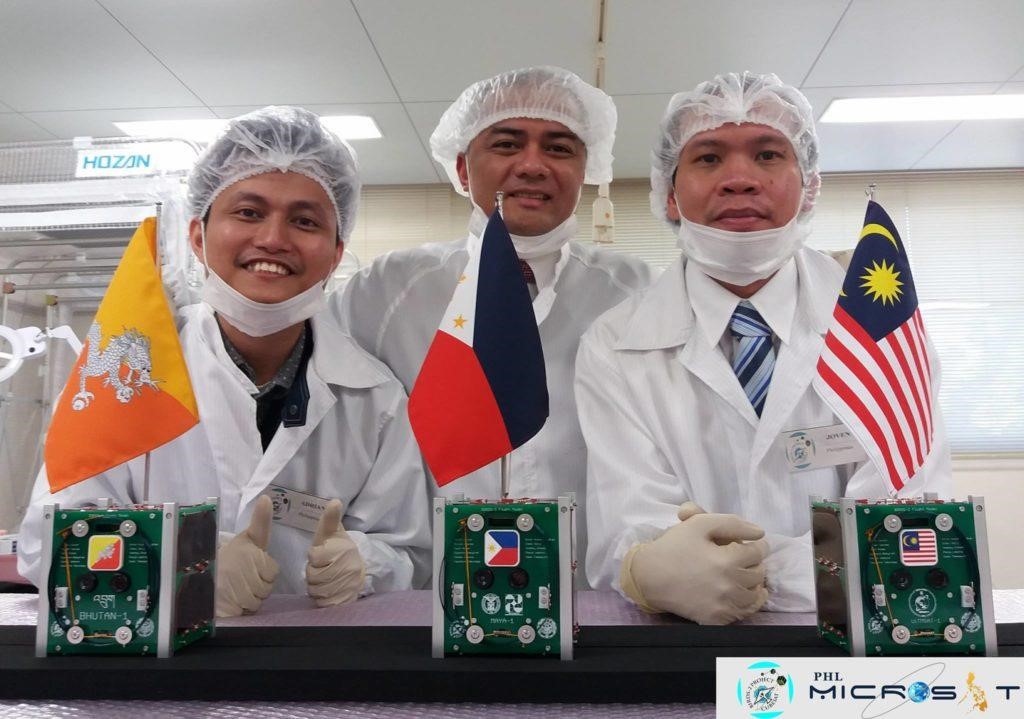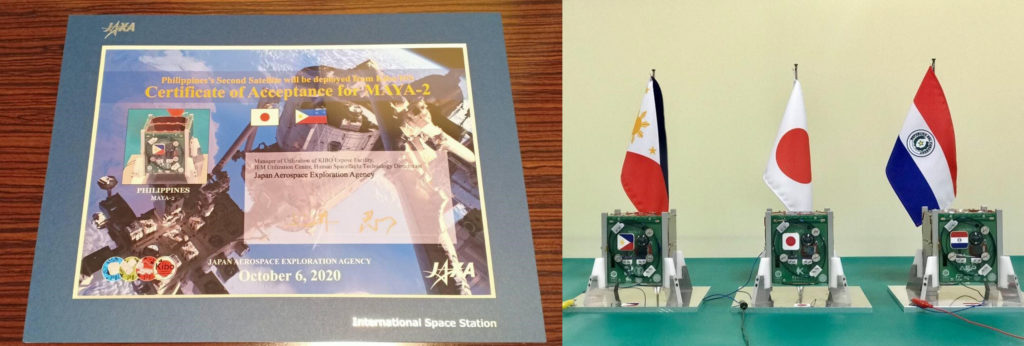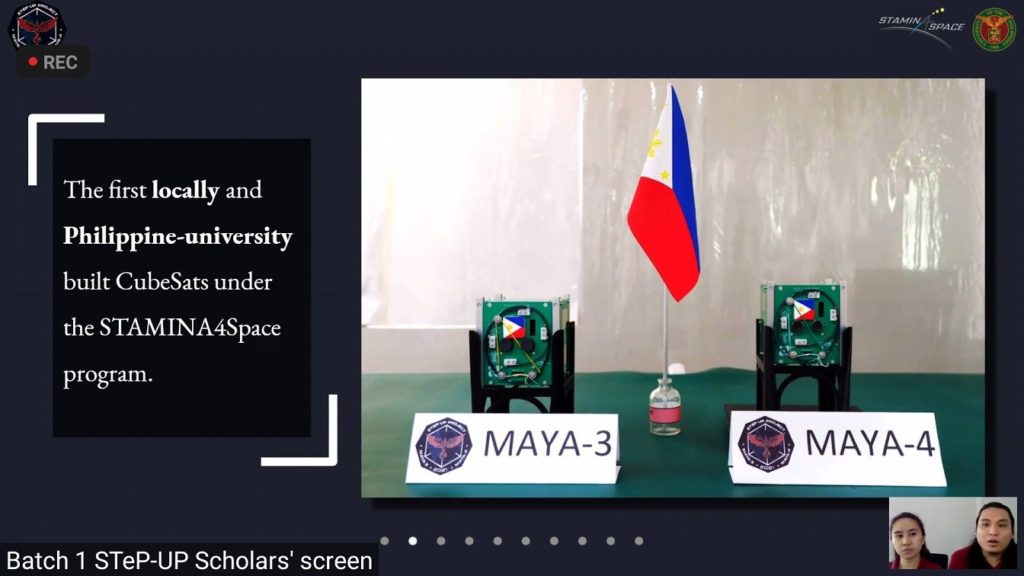The Philippine Space Program is surging forward and its leaders are being true to their word of having the country’s satellites made by Filipinos. The second batch of eight Filipino scholars who will construct the Philippines’ Maya-5 and Maya-6 cube nanosatellites (nanosats or cubesats) were recently presented to the public in a virtual event.
Coming from different backgrounds, schools and areas, the second batch of scholars are: Gio Asher Tagabi from Quezon City; Chandler Timm Doloriel from Surigao del Norte; 2nd Lt. Genesis Remocaldo from Clark Air Base, Pampanga; Anna Ruth Alvarez from Misamis Oriental; Angela Clarisse Chua from Manila; Joseph Jonathan Co from Valenzuela City; Ronald Collamar from Bulacan; and Khazmir Camille Valerie Macaraeg from Quezon City.
The new batch was chosen while the pioneering first batch of Filipino scholars, led by Project Manager Renzo Wee, was constructing the Maya-3 and Maya-4 nano-sats and finishing their graduate studies.
The scholarships are under the Space Science Proliferation through University Partnerships (STeP-UP) Project, a Masters in Engineering Program with a nanosatellite engineering track under the University of the Philippines Diliman Electrical and Electronics Engineering Institute (UPD EEEI).
SteP-UP is a component of the Space Technology and Applications Mastery, Innovation and Advancement (Stamina4Space) Program.
MAYA-1 TO 4

The cube nanosatellites weigh a little more than 1 kilogram and with size 10 centimeters cube.
The Maya-3 and Maya-4 cubesats are scheduled to be launched in February 2021. Their fabrication started in January 2019.
Maya-2, the Philippine’s second cubesat, has been completed and turned over to the Japan Aerospace Exploration Agency (Jaxa) in Japan on Sept. 24 in a handover ceremony hosted and organized by the Kyushu institute of Technology (Kyutech).
Maya-1, meanwhile, the country’s first nano cubesat, flew back to the earth’s atmosphere on Nov. 23. It stayed in orbit for about two years and four months.
VIBRANT SPACE ENERGY
Stamina4Space Program Leader Dr. Gay Jane Perez said the scholarship program includes lectures, hands-on activities and training on the development of cube nanosats.
It is complemented by partner Kyutech in Japan through training and guidance on space environment test, Perez said.
It will culminate in the development, launch and operation of Maya-5 and Maya-6 based on the success of the first UPD-built Maya-3 and Maya-4 cubesats.
“Our dream of creating a vibrant space industry starts in planting the seeds of knowledge for the future generation of space science and engineering like our nanosat engineering,” Perez said.
She also told the new scholars during the webinar that while it may be in a challenging time right now, “rest assured that the Stamina4Space Program will give you unwavering support through mentoring and guidance on the development of the new cubesats.”
ENCOURAGING YOUTHS
Science Secretary Fortunato T. de la Peña said the new scholars should “take pride in and be humbled by this rare opportunity… in building on a pioneering effort that will push the boundaries of what the Philippines is capable of, especially in the space industry.”
He said the scholars’ efforts will bring a significant contribution to the Philippines’ future space activities and the country’s space program, which can open more op- portunities for offering courses like this, not only in UP, but in other universities as well.
“You play a significant role in encouraging the youth who are considering education and careers in STEM [science, technology, engineering and mathematics]—par- ticularly space science and technology,” he said in his keynote message in the webinar.

De la Peña pointed out: “Our collective efforts are living proof that, indeed, space is not just a dream anymore for Filipinos because we have already reached it and will continue to go further and contribute to innovation.”
SHARING SPACE TECH
Philippine Space Agency (PhilSA) Director General Joel Joseph Marciano Jr. said the nanosatellite technology will be openly shared not just to universities but also to high-school students.
Marciano has been saying that the country’s space program will have a sustainable manpower by encouraging students to take courses in different aspects of space technology.“
“The nanosatellite [technology] you are working on now, we want to see that in high schools in the Philippines in the near term,” he told the scholars during the online meeting.
Marciano added that goal “is very much achievable because we are openly sharing it and disseminating it through mentorship and partnership.”
He said the lessons learned in making Maya-3 and Maya-4 in the country “are milestones because we are localizing the knowhow and we are increasing the local inputs and engagements.”
Marciano further said that the skills the new batch of scholars will learn “will put our country at a very strong advantage. it will make us competitive. it will future proof us and it will contribute to our economic growth by creating competitive industries, by creating jobs.”
STeP-UP Project Leader Paul Jason Co agreed, saying, “if we want to build our own local space industry, more needs to be done.”
He said the Stamina4Space program “brings knowledge back home and builds up our capabilities and cultivates our space science technology and applications ecosystem.”
“in order to build and sustain this ecosystem,” Co said, “the academe must ensure that capable researchers and scientists and engineers will continue to be developed,” in a manner that will sustain this industry and ecosystem.

BIRDS PROJECT
Gio Asher Tagabi, Maya-5 and Maya-6 project manager, said the cubesats they will make will use the Birds-4 as platform. it is a component of the Birds Project, a joint global multination cubesat constellation project hosted at Kyutech in Japan.
Led by Kyutech, the Philippines is one of the participating countries in the Birds Project starting in Birds-2, the plat- form for Maya-1 in making Maya-5 and Maya-6, the team will push the country’s satellite de- velopment “while transitioning to locally fabricated satellites by designing, build- ing, testing, launching and operating satellites that will serve as heritage for future cube satellite missions.”
The parts of the satellites the team will use are sourced from Kyutech.
“Eventually we will fabricate all the parts of the satellites in the Philippines,” Tagabi said.
LAUNCH DATE: MARCH 2022
In the two-year program, Tagabi said the development of the Maya-5 and Maya-6 started in September with the team doing research about the satellites.
Since the parts are not yet in the country, the team started to learn how the satellites work, and reviewed the previous documents of Birds 4.
As the parts of the nanosats start arriving in the country this December, the team will start working on the two nanosats.
The scholars will go to Japan to test the engineering model of the nanosats in May 2021.
They will have the critical design review and start the assembly of the flight model in June.
They go back to Japan in Kyutech for the flight model testing and environment test in September.
During this period the scholars will be busy with several activities, including their studies.
“Our next project schedule is the turnover to Jaxa in October 2021, and the launch [of Maya-5 and Maya-6] from the international space station in March 2022,” he said.
FUNDING FOR SCHOLARS
Director Josette Biyo of the DOST-Science Education Institute said the DOST- SEI, which provides funding for the scholarship, will continue to support the country’s local and foreign space technology scholars “in order to produce and strengthen the human resource in space science technology and engineering.”
Biyo noted that among the current space technology scholars are three doctoral degree students, and the first and second batches of Maya teams “who passed rigid screenings.”
“The DOST-SEI will give its full support as you reach for your dreams, as you fly your own satellites in the near future and as you reach for your stars,” she said.
NOT ONLY FOR THE RICH
UP Diliman Chancellor Dr. Fidel Nemenzo, who witnessed the launching of Diwata-1 and Maya-1, said it was an “exciting time,” as he also looked forward to the develop- ment of the country’s own facility in UPD and the launching of programs of STeP-UP.
Nemenzo agreed with de la Peña that the launching of the country’s satellites has the power to inspire students and young children to study courses in STEM.
“Every launching of a satellite breaks down the psychological barrier for many young and aspiring scientists,” he said in the same webinar.
Nemenzo pointed out: “Space technology is no longer something we read in books or see in movies. And space is no longer the exclusive territory of the advanced and industrialized countries and superpowers. Space technology is within our reach especially with the support of the public and the government.”
He said the satellites program provides a venue for knowledge dissemination and communication as it is the responsibility of scientists and engineers to inform the government and the public that support for S&T is “important for national development.”
“We need to explain why we go to space, why the data we get from satellites are useful for many applications, such as weather prediction, disaster risk reduction, for rational planning of natural resources, for food security, etc.,” Nemenzo said.
He reiterated that the Step-UP program and Stamina4Space is not only for UP. “it is a multiplier program designed to help expand the community, to help other universities and institutions to develop their own science and engineering programs,” he said.
“This program is a step to help build toward the establishment of a sustainable national space program under the Phil-SA,” Nemenzo added.
USEFUL FOR POLICY- MAKERS
UP College of Engineering Dean Ferdinand G. Manegdeg said, that “though it is very much smaller than its predecessors, its [nanosats’] importance to communication and disaster-related concerns is not diminished.”
He said photographs taken by the smaller satellites can very much be used by policymakers and stakeholders to craft policies that will impact the environment.
“Saying that these nanosatellites are essential to the economy is an understate- ment,” Manegdeg added.


